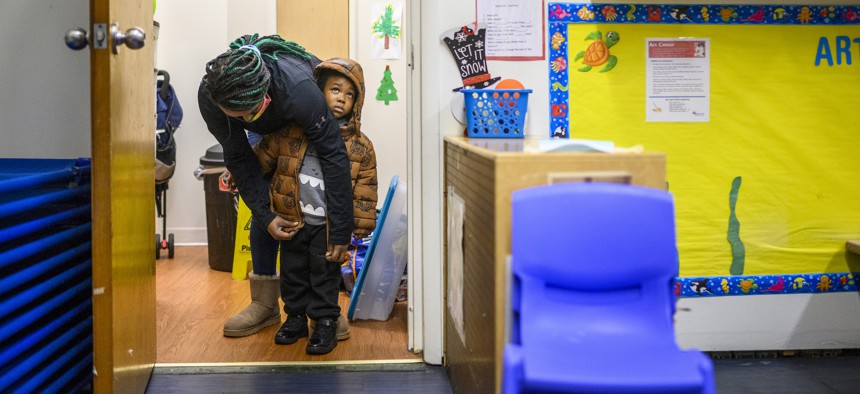These pandemic-era relief programs expired in 2023

A pandemic program that made child care affordable for more families ended earlier this year, along with a host of other initiatives that reduced evictions and food instability. Matt Roth for The Washington Post via Getty Images
As the federal government rolled up its pandemic-era social safety net, state and local governments stepped in to fill the gaps in housing, child care and food assistance.
With the end of the national public health emergency, several pandemic-assistance programs terminated in 2023. For many families, that meant less money for rent, child care and groceries at a time when inflation is pushing everyday costs ever higher. Here’s a breakdown of which benefits ended and how state and local governments are working to fill the gaps.
Emergency Rental Assistance
The last of the $46 billion in federal Emergency Rental Assistance funding dried up this year. Overall, the pandemic-relief program and the eviction moratorium were considered successful in keeping millions of people housed during the pandemic. The rental assistance program issued more than 12 million payments to households: Approximately two-thirds of recipients had very low incomes, and about 60% of funding went to households of color.
But the need for rental assistance continues. The U.S. Department of Housing and Urban Development recently reported that overall homelessness increased 12% between 2022 and 2023, and officials pointed to skyrocketing housing costs as a primary force pushing people out of their homes. When those safety nets were withdrawn, eviction filings in some cities increased by as much as 50% beyond pre-pandemic levels.
Over the past year, cities and states have stepped up to fill in the gaps left by the end of pandemic housing relief.
Colorado had an especially big lift. U.S. News & World Report ranked the state as one of the least affordable in the country, and in 2023 some parts of the state saw the highest numbers of eviction filings on record, according to The Colorado Sun. But during a special legislative session last month, the state approved $30 million in rental assistance that will be available until the end of the fiscal year in June 2024. The Denver City Council also pushed through nearly $30 million in assistance—nearly double what Mayor Mike Johnston had initially sought.
Other states have also approved major boosts to rental assistance, including Minnesota, where the legislature in March passed a law allocating $50 million for emergency rental assistance.
Child Care
The country flew over a “child care cliff” in September when the nearly $40 billion in emergency aid for child care under the American Rescue Plan Act terminated. The funding helped providers cover rent, purchase supplies and increase wages for staff, thereby keeping tuition costs down. Many feared that the end of pandemic assistance would result in millions of children losing care, and several states bolstered programs to help families and child care centers.
With enhanced federal funding gone, states are committing their own money and adjusting regulations to make child care more accessible. In June, for instance, Montana approved a measure that will provide a $7 million annual boost to a program that helps low-income families pay for child care. A separate measure exempts small, in-home daycare centers from some state licensing requirements. Earlier in the year, Minnesota made headlines for legislation that will invest $750 million in early education. The funding includes money for educating teachers, raises reimbursement rates for providers and makes available scholarships and a child tax credit that will give low-income families up to $1,750 per child.
Minnesota also rolled out a child tax credit. Child poverty plummeted during the pandemic, and many point to the federal enhanced child tax credit as a major driver of the roughly 50% decrease. At least 11 states have passed fully refundable child tax credits since 2021, according to a recent report from the Jain Family Institute, a research organization that studies social issues.
While these credits put money in the hands of low-income families and help many with some of their child care costs, they’re typically not enough to fully cover tuition and don’t reach everyone in need. A combination of other benefits—including the child and dependent care tax credit, the earned income tax credit and the employer-provided child care tax credit—reach a broader range of stakeholders and make child care more affordable.
There’s interest in Congress to help child care providers, too. In September, a group of federal lawmakers introduced the Childcare Stabilization Act to provide $16 billion annually for the next five years to help support child care businesses.
Food Stamps
In late March, Massachusetts passed a $388 million supplemental budget, with a third of that funding going to help families cover food costs through June. The move came just a few weeks after enhanced federal benefits under the Supplemental Nutrition Assistance Program, or SNAP, ended.
“Providing a glide path for SNAP recipients losing critical nutrition benefits and ensuring school meals for all continues in this school year will help to offset the overall impact of individuals and households who are struggling with food access,” said Catherine D’Amato, president and CEO of The Greater Boston Food Bank, in a statement.






